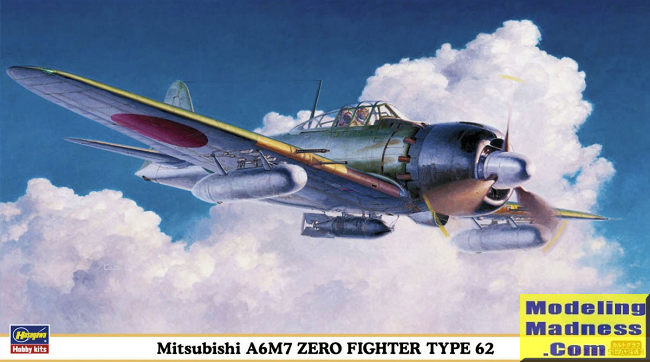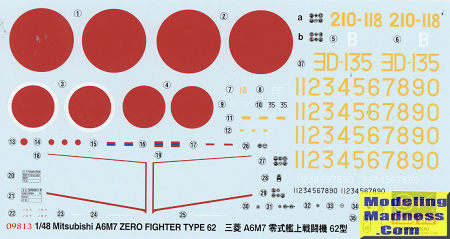
Hasegawa 1/48 A6M7 type 62
| KIT #: | 09813 |
| PRICE: | $2160 yen on sale |
| DECALS: | Several options |
| REVIEWER: | Scott Van Aken |
| NOTES: | 2008 boxing, 2018 reissue |

| HISTORY |
The A6M6/7/8 were based on the A6M5 so I thought it would be appropriate to provide some information on this variant. The A6M5 is sometimes considered as the most effective variant, the Model 52 was developed to again shorten the wings to increase speed and dispense with the folding wing mechanism. In addition, ailerons, aileron trim tab and flaps were revised. Produced first by Mitsubishi, most Model 52s were made by Nakajima. The prototype was made in June 1943 by modifying an A6M3 and was first flown in August 1943. The first Model 52 is said in the handling manual to have production number 3904, which apparently refers to the prototype.
Research by Mr. Bunzo Komine published by Mr. Kenji Miyazaki states that aircraft 3904 through 4103 had the same exhaust system and cowl flaps as on the Model 22. This is partially corroborated by two wrecks researched by Mr. Stan Gajda and Mr. L. G. Halls, production number 4007 and 4043, respectively. (The upper cowling was slightly redesigned from that of the Model 22.) An early production A6M5 Zero with non separated exhaust, with an A6M3 Model 22 in the background. A new exhaust system provided an increment of thrust by aiming the stacks aft and distributing them around the forward fuselage. The new exhaust system required "notched" cowl flaps and heat shields just aft of the stacks. (Note, however, that the handling manual translation states that the new style of exhaust commenced with number 3904. Whether this is correct, indicates retrofitting intentions, refers to the prototype but not to all subsequent planes, or is in error is not clear.) From production number 4274, the wing fuel tanks received carbon dioxide fire extinguishers. From number 4354, the radio became the Model 3, aerial Mark 1, and at that point it is said the antenna mast was shortened slightly. Through production number 4550, the lowest exhaust stacks were approximately the same length as those immediately above them. This caused hot exhaust to burn the forward edge of the landing gear doors and heat the tires. Therefore, from number 4551 Mitsubishi began to install shorter bottom stacks.Nakajima manufactured the Model 52 at its Koizumi plant in Gunma Prefecture. The A6M5 had a maximum speed of 565 km/h (351 mph)) at 6,000 m (20,000 ft) and reached that altitude in 7:01 minutes. Please visit the reference link for information on the many variants.
The A6M6 was similar to the A6M5c, but with self-sealing wing tanks and a Nakajima Sakae 31a engine featuring water-methanol engine boost. The A6M7 was similar to the A6M6 but intended for attack or Kamikaze role.
| THE KIT |
 This
is at least the second complete boxing of the A6M7. According to Scalemates,
there was another that was an a6M5/7 release. I don't know if the initial boxing
included resin parts (as did the initial A6M8 release), but all the additional
bits (which are basically wing fuel tanks and centerline bomb rack/bombs) are in
plastic.
This
is at least the second complete boxing of the A6M7. According to Scalemates,
there was another that was an a6M5/7 release. I don't know if the initial boxing
included resin parts (as did the initial A6M8 release), but all the additional
bits (which are basically wing fuel tanks and centerline bomb rack/bombs) are in
plastic.
This kit comes in a fairly full box. There are different sprues for this variant which includes the above mentioned items. It may also have a different cowling, but I'm not that much up on Zeros to be sure.
The cockpit is the same as we've seen in Hasegawa 1/48 A6Ms since this molding first hit the streets. That is to say it is very good and the only thing it really needs is a seat belt/harness. There are raised details for the instruments and decals to fit over them. Note that this version has no cowl machine guns so you'll have to fill the holes for the breeches. There are various other holes that need to be opened in the fuselage, including one for a small window. Though this has a new cowling, it is in two halves so you'll need to deal with a seam. There is a one-piece prop that goes with this with the larger spinner so no individual blades.
The wing iis the one that has the reinforcements on the underside and is able to take either wing fuel tanks or various bomb options. There is a large 250 kg bomb for the centerline. One will have to drill a hole in one of the rectangular pieces that fit on the centerline to use this option. You also need to fill some pre-drilled holes and other items on the airframe to duplicate this variant. If one doesn't want to install the wing tanks, there are three other size bombs and you can either install two of the very smallest of one of the other two larger sizes. The two smaller sizes are air to air bombs and have separate twisty fins. Like the other versions, there are separate (lowered) flaps. No tail hook or center fuselage fuel tank so there are inserts for those. The canopy is in three pieces so you can pose it open though I think the sliding portion may be a tad thick.
 Instructions
are standard stuff with Gunze paint references. Both markings options are green
over light grey with leading edge ID markings. These latter items will need to
be painted on as the area is fairly convoluted and a decal just wouldn't do it
justice. Markings are for planes with the 210th Naval Flying Group and for the
302nd Naval Flying Group. The instructions state that the latter may be a type
52hei as apparently they are quite close. The decals are printed by Cartograf
and provide a variety of additional code numbers for the 302nd. These respond well to most setting solutions.
Instructions
are standard stuff with Gunze paint references. Both markings options are green
over light grey with leading edge ID markings. These latter items will need to
be painted on as the area is fairly convoluted and a decal just wouldn't do it
justice. Markings are for planes with the 210th Naval Flying Group and for the
302nd Naval Flying Group. The instructions state that the latter may be a type
52hei as apparently they are quite close. The decals are printed by Cartograf
and provide a variety of additional code numbers for the 302nd. These respond well to most setting solutions.
| CONCLUSIONS |
As I mentioned when doing the A6M8, anyone who does a full range of Zeros will need to add this one to their collection. I'm not sure if Hasegawa does or has done an A6M6 but I'd be surprised if they did not.
| REFERENCES |
https://en.wikipedia.org/wiki/Mitsubishi_A6M_Zero
October 2018
Copyright ModelingMadness.com. All rights reserved.
Thanks to me for providing the preview kit.
If you would like your product reviewed fairly and fairly quickly, please contact the editor or see other details in the Note to Contributors.
Back to the Main Page Back to the Previews Index Page Back to the Review Index Page